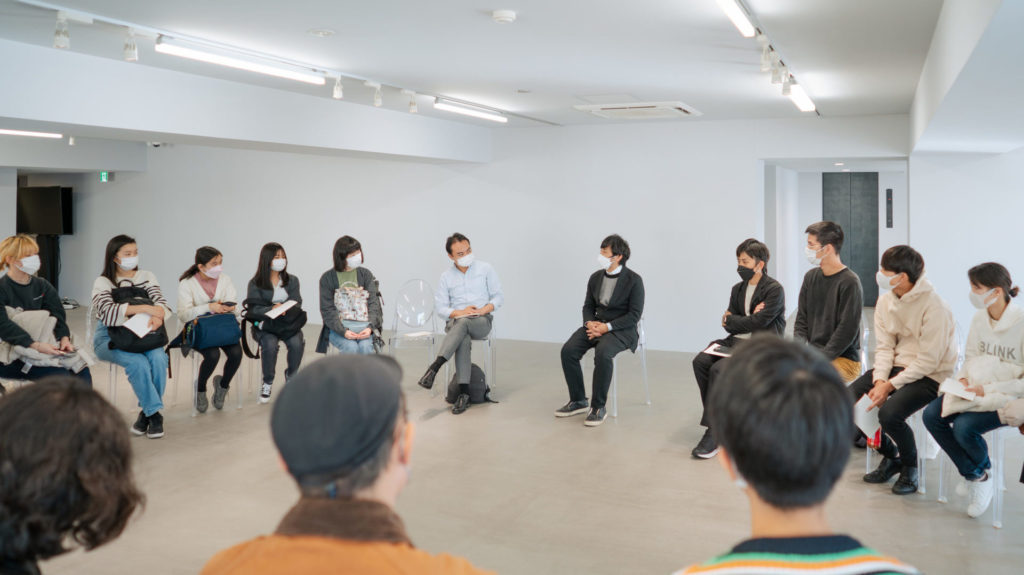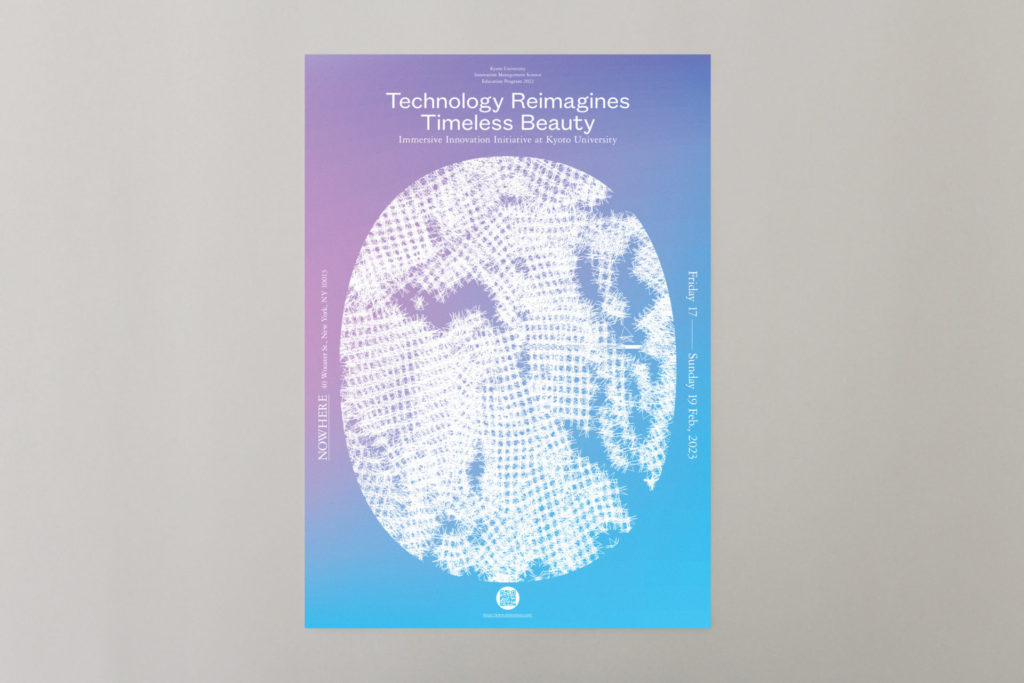
Technology Reimagines Timeless Beauty >>Exhibition Info
February 17th – February 19th, 2023
2022年秋から冬にかけて、日本の高校生や大学生21名が、京都の伝統的な美術・工芸の工房を訪問し、レクチャーやワークショップなどの多彩なプログラムを体験しました。第一線で活躍するメンターとの対話を重ね、バックグラウンドが異なるメンバー同士でチームを組み、フィールドワークで発見したことをヒントに、AIやブロックチェーンなどの最先端の技術を用いて、5つの作品を制作しました。本展はニューヨークのSOHO地区にあるNowHere Galleryにおいて、これらのプロセスを紹介すると共に、学生たちが制作した作品を発表します。
In Fall/Winter 2022, twenty-one young talents from Japan, from late teens to early twenties, embarked on a one-of-a-kind journey around Kyoto, where they participated in workshops, field trips, lectures, and visits to artisans. Guided by mentors at the forefront and collaborating with interdisciplinary peers, the participants apply modern technologies such as AI and blockchain to create five artworks that showcase their findings and entrepreneurial curiosities. Be a part of this journey and witness the intersection of technology and art, where culture is cultured.
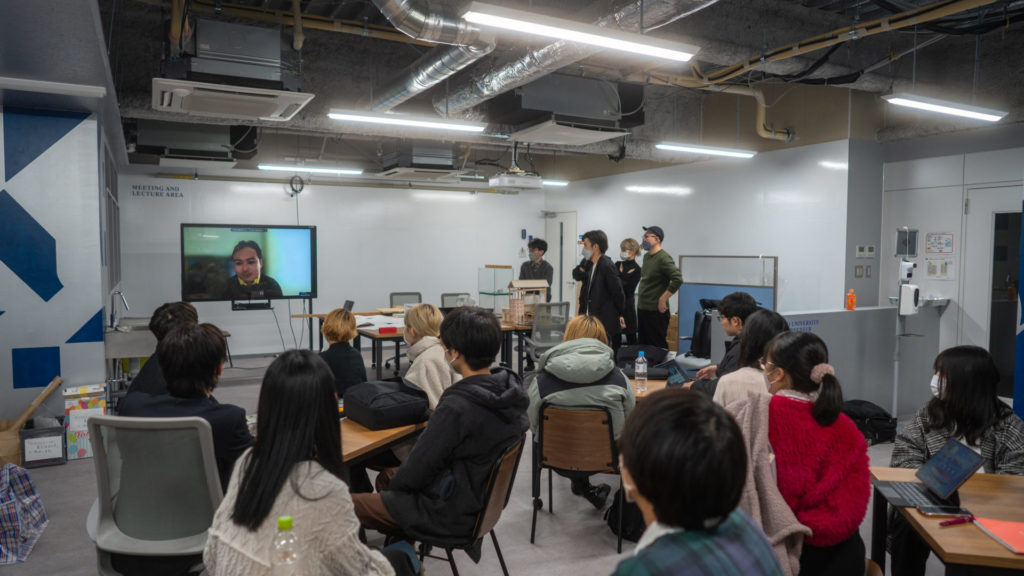
Dialog: Masatoshi Honda × Eikoh Tanaka
プログラムのはじまり The Beginning of the Program
本多:京都はとても好きな都市でした。これまで断片的なご縁しかなかった場所ですが、この多様なニューヨークに住む中で、自らのルーツを考えたとき、京都大学の仕事は面白いと思ったのと、大学のリソースは可能性に満ちていると思い、教鞭をとる事を決めたという経緯があります。アメリカに住んで生活している方々にとってもユニークで刺激的な物を提供するヒントになればとも思いました。
Honda: Kyoto was a city that I really loved. I’ve only had a fragmented relationship with Kyoto, but when I considered my roots while living in this diverse city of New York, I thought to myself that working at Kyoto University would be interesting, and that the resources of the university had great potential, which led me to accept a teaching position there. I thought it would provide a hint of something unique for those who live and work in the United States.
特に私が大事にしてるのは、大学の中でも常に新しいことをやっていきたいという部分です。その中でも新しい教育プログラムを作るということは重要だと思っていました。既存の大学、高校のシステムではカバーしきれない教育の可能性を探りたいとこの十年ほど考えていましたから。社会における「媒介(media)としての大学」という考え方にすごく興味がありますね。そんな中で今回、三菱みらい育成財団の助成を受けて「異能」を開発するプログラムを作ることになり、多くのフィールドワーク、またアーティスト含めた専門家のレクチャーを組み込んでいましたので、それらを通して自分自身が学ぶような設計ができれば、きっと良い教育プログラムになるだろうと考えました。
One thing that I particularly value is the drive to continue trying new things within the university. I felt it was important to create a new educational program within that environment. The reason being that I had spent the last ten years looking at the possibilities in education that are not currently covered in the existing university and high school systems. I am very interested in the idea of the “university as a medium” within society. It was with this intent that I received a grant from the Mitsubishi Mirai Ikusei Foundation to build a program that would develop “innovative talents” by incorporating substantial fieldwork and lectures by specialists, including artists. By enabling oneself to design their own educational path, I thought that this would surely become a great program.
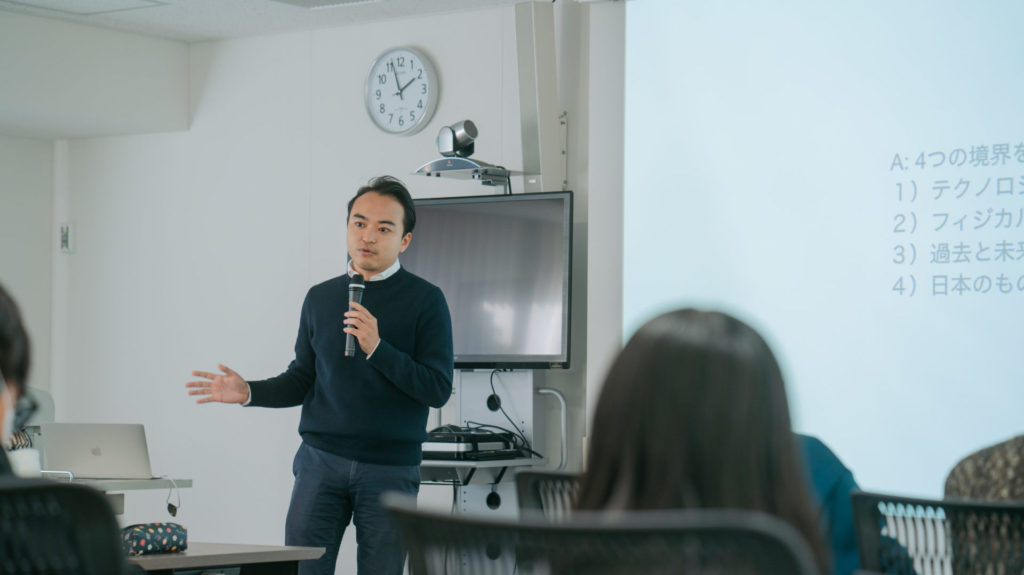
伝統美の再解釈 Reinterpreting Traditional Beauty
本多:今回のプログラムで重要なキーワードでもある「日本の美」についてですがこれは、多面的にとらえるべきだと考えています。アートとか、デザインという言葉でくくれるものでは無いし、日本でも敬遠されることもありますよね。ただ私の専門家的視点から、サイエンス的に捉えたらこの美には、この解釈が成立しうるとか、さらには事業家視点で見ればこの考え方が有効だとか、特にそのエンジニアリングとの距離は非常に近しい言葉だと考えています。そしてこの世界の中で、京都か持っているポテンシャルの一つはこの「日本の美」についての再解釈が必須だと思っていました。そしてもう1人のプログラム設計者である田中英行さんとディスカッションしていく中で今回のプログラムには「テクノロジーが美となるとき」というタイトルに決め、テクノロジーが軸となりながら、その日本的な美と交わる、もしくは美そのものにテクノロジーがなり得るということを日本の若者たちと具象化を試みたわけです。
Honda: “Japanese beauty” is an important keyword for this program, one that I believe should be approached from multiple perspectives. It’s not something that can be categorized as art or design, and even in Japan, it’s often dismissed. However, from my professional point of view, approaching this beauty from a scientific angle can yield one type of interpretation, while approaching it from a business perspective might reveal a different way of thinking that is more effective. I think it’s a word that’s very similar to the term “engineering” in its wide range of application. I felt that Kyoto held much potential in this world, essential among them being the potential to reinterpret this “Japanese beauty.” After discussions with another program designer, Hideyuki Tanaka, we decided on the title of this program, “When Technology Becomes Beauty,” working with young people of Japan to generate an experiment centered on technology and its intersection with beauty, where technology itself can become beauty.
このプログラムの受講者は京大の学生を中心に、日本各地から集まった大学生と高校生が受講生となりました、専攻も工学系から美術系までさまざまな年齢と専門性をもった若者が集まりました。また講師、メンター達も同じく、科学者、アーティスト、起業家、エンジニアなど、多様な先生がこのプログラムに協力してくれています。
The participants in this program were primarily students from Kyoto University, along with university and high school students assembled from all over Japan, ranging in age and areas of study that spanned engineering to fine arts. The same goes for our instructors and mentors, who comprise a diverse group including scientists, artists, entrepreneurs, and engineers who have helped us with this program.
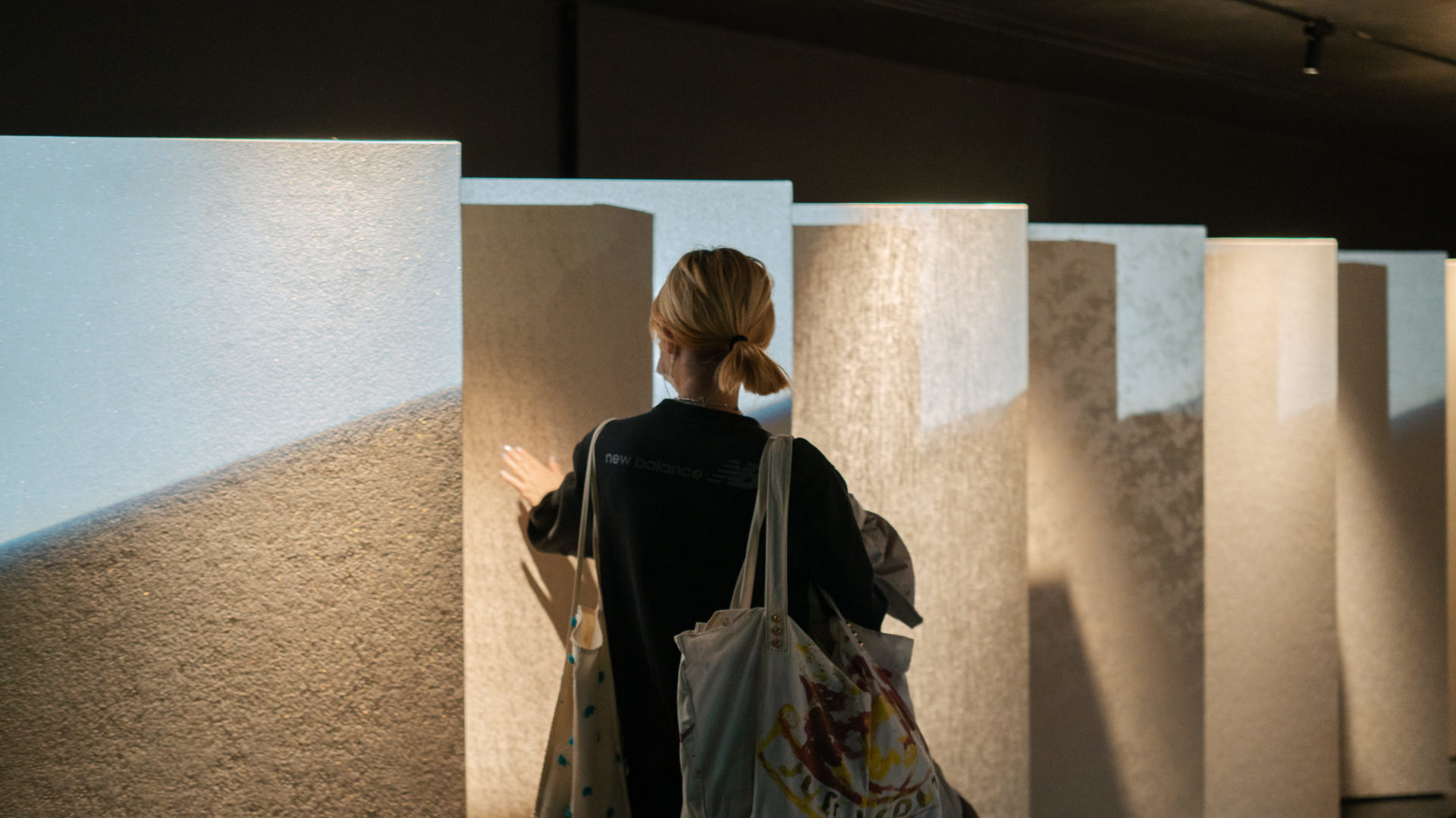
イノベーションによって新産業を作る Creating New Industries through Innovation
本多:私の父はエンジニアでしたが、母や祖母は日本伝統芸能の長唄を仕事にしてきました。東京の家には畳や着物があり、私も10歳ごろまで国立劇場にて演奏をしました。一方、最初の学校はインターナショナルスクールで、世界中の子供達と遊んでいました。そして家は仏教の浄土真宗なんですけど、学校はキリスト教の小学校に通っていました。日本育ちではありますが、両極な価値観に触れながら育ったと思います。
Honda: My father was an engineer, but my mother and grandmother worked in the traditional Japanese performing art of nagauta. My house in Tokyo had tatami and kimono, and I performed at the National Theater until the age of ten. Meanwhile, my first school was an international school where I played together with children from all over the world. My family was affiliated with Jodo Shinshu Buddhism, but I attended a Christian elementary school. Although I was raised in Japan, I think I grew up exposed to polar values.
10年ほど前、TEDxUTokyoをの設立者として、専門性の垣根を越えてたくさんの学生と交流する機会もありましたし、SXSWにてゲノム編集と接木の展示をしたこともあります。それらの経験や時間が今回のプログラムにも影響を与えていますね。バイオテクノロジースタートアップの起業から経営を色々とやってきましたから、技術系の大学の学術とかを利用し新産業を作っていくようなイノベーションが専門です。コロンビア大学で大学院の時にも、今NYに住んでいる時もですが、日本人として自分を強く意識する場面も多くあってですね、受け継がれてきたポテンシャルをもっと生かす方法は無いのだろうか?と考えることが多くありましたね。
About 10 years ago, as the founder of TEDxUTokyo, I had the opportunity to interact with many students across specialties and held an exhibition of genome editing and grafting at SXSW. Those experiences and times have had an impact on this program. I’ve been involved with the many facets of a biotechnology startup, from the initial launch to ongoing management, and I now specialize in innovation that creates new industries through technology-focused university academics. Both when I was in graduate school at Columbia University and now in my current life in New York, there have been many situations where I was very conscious of myself as a Japanese person, and I would wonder if there was a way to make the most of whatever potential I had inherited.
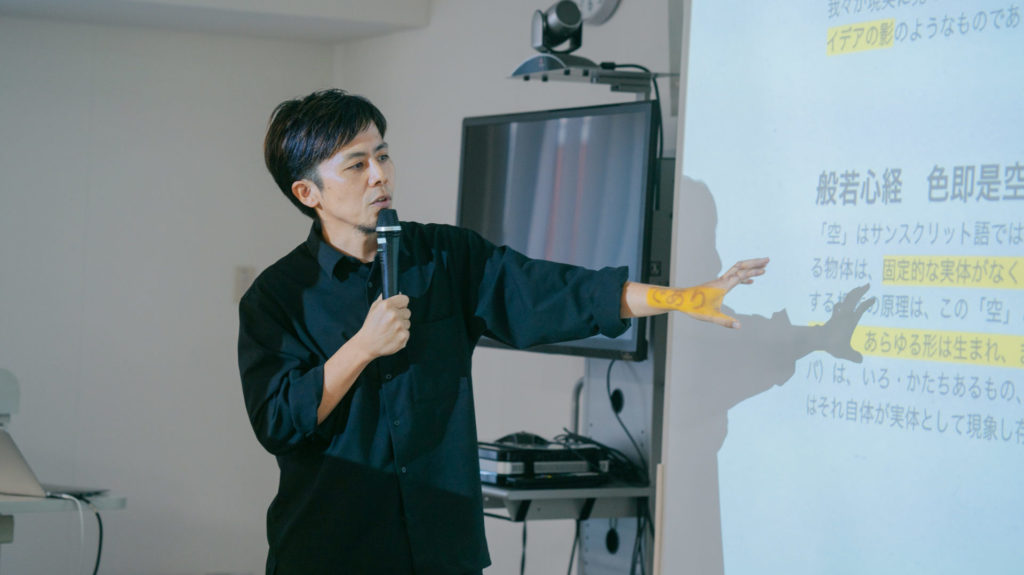
アートは人の意識を変容させる Art Transforms Human Consciousness
田中:僕は20年ほど現代アートのアーティストとして生きてきましたが、その中でアートの限界を感じていました。社会全体を変革させるような大きなムーブメントをアートによって起こすのは非常に難しいなと。投資対象や鑑賞物となること、限られたコミュニティーへの影響は作れるかもしれないが、社会全体を大きく変えるのに「アート」という既存の業界やジャンルのあり方に対しての限界を日々感じてきました。一方でアートには人の意識を変容させるとか、新しい価値を生み出すとか、人類の精神構造、世界の見方を一変させるようなきっかけを作ることは可能だと考えているし、そのアートの可能性は信じています。
Tanaka: I’ve been a contemporary artist for about 20 years, and I’ve always felt the limits of art. I think it’s very difficult for art to create movement substantial enough to transform the whole of society. Art may be seen as an object of investment or an item of appreciation, and it may influence a limited community, but I feel every day that there is a limit to how the “art” industry and genre in their existing forms can change society at large. On the other hand, I believe in the potential for art to transform people’s consciousness, create new value, and offer moments that can completely change human mentality and the way we see the world.
そんな思いの中で、アートと社会の中間領域において、社会全体をより良き方向に導けるようなことが起こせないか?と模索していました。そしてアーティスト視点からアート思考に関するプログラムをいくつか実践する中で、アートの手法を使ってより多くの人々を覚醒させることができれば、人間としての可能性を開くことができれば、より大きなソーシャルインパクトになるだろうと考えるようになりました。
With that in mind, I wondered if I could spark something in the middle ground between art and society that would lead society as a whole in a better direction. From my own perspective as an artist, I implemented a number of programs in art thinking, and I began to feel that if we could awaken people through the means of art, and if it opened up our own postential as human beings, that we would be able to have an even greater social impact.
今まで自分がアーティストとして考察してきた、世界の見方やものの捉え方、コンテクストの編み方などを活用し、0を1へとその価値創造を行う。そのプロセスを整理して教育プログラムへと昇華しようと思っていたところに、今回プログラムの話をいただいたので、ぜひ挑戦したい!となったわけです。
As an artist, I have been considering how ways of seeing the world, perceiving things, and weaving together contexts can create value from zero to one. While I had been thinking of organizing that process and channeling it into an educational program, I heard about this program and felt moved to try it!

アート×テクノロジーが起こすイノベーション Innovation through Art × Technology
田中:アートの限界を超えるのに、アート以外の「何か」と結びつく必要があると思っています、テクノロジー、サイエンス、ビジネスと交わることで、これまでになかった新しい価値を生み出すっていうことがありますよね。本多正俊志さんはバイオテクノロジーのスタートアップを起業したり、研究者でもあり、多様な側面をもつ方なので一緒にプログラムを作ることで、異色の新しい教育プログラムができるだろうという期待値も大きかったですね。
Tanaka: I believe that in order to transcend the limits of art, it is necessary to connect with “something” outside of art. By merging technology, science, and business, we can create new value that didn’t exist before. Mr. Masatoshi Honda holds diverse perspectives as a biotechnology start-up entrepreneur and a researcher, so we had high expectations that by working together, we would be able to create a new and unique educational program.
若い世代に刺激的な異能開発の教育プログラムを体験してもらい、将来において才能が開花するようなきっかけが作れたら最高ですよね。アート思考は人の心が本当に求めているもの、自分が人生で本当にやりたいことなど、自分のコアを捉えるにはとても良いツールになります。なので僕はこの部分に強く作用するようなプログラムの設計を行いました。
As younger generations learn through this dynamic educational program for developing new talents, it would be great if that experience then creates opportunities for their abilities to blossom in the future. Art thinking is a very good tool to engage with the core of your personality, understanding what we as people are truly seeking, and what each of us truly wants to do in life. So, I designed a program that strongly activates this part of who we are.
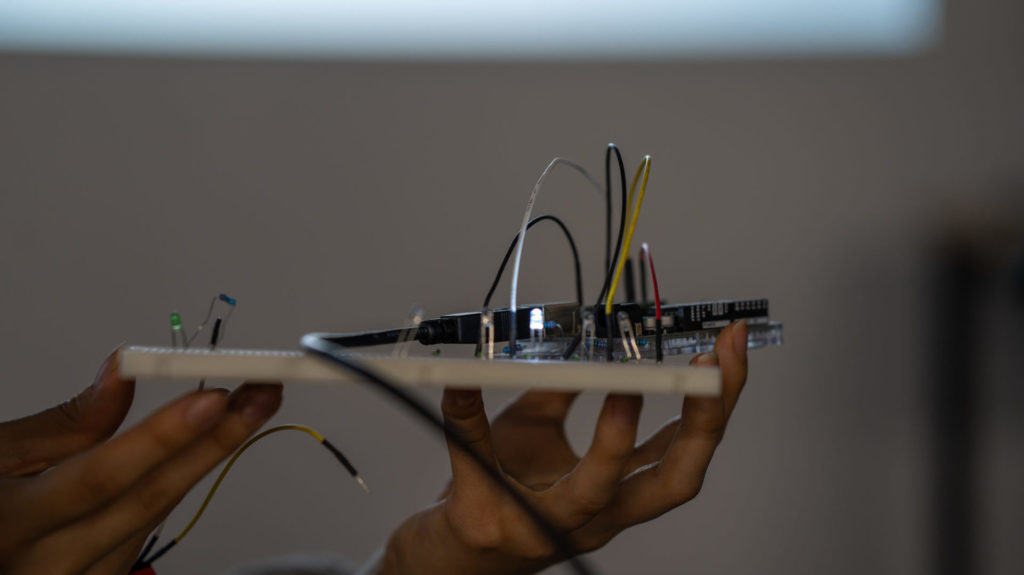
1000年の歴史と繋がる街 A City Connected to 1,000 Years of History
田中:僕は京都の田舎で生まれ育ったのですが、その土地に600年以上住み続けている家系です。京都人が思い出す戦は第二次世界大戦ではなく、応仁の乱(15世紀後半)というのが有名な話ですが、私の祖先はその前に今の地に住み着いた、その先祖から僕へと繋がっています。今残っている生家も百年前の木造です。私の家の前は約400年前に「本能寺の変」によって逃げてきた兵士が多く亡くなっていると聞きましたし、さらに京都市内では街の至る所に、千年ほどのタイムスパンで歴史と繋がる場が多く残っています。この通常想像していないようなタイムスパンで、今も自分と遠い時間を接続することが可能な年は世界でも多くないと思います。
Tanaka: I was born and raised in the countryside of Kyoto, where my family has lived for over 600 years. It is often said that the war that Kyoto people remember is not World War II, but the Onin War (late 15th century). My ancestors settled in this land even before that, and we are connected – all the way from their ancestors to me. The house where I was born, which is still standing, is a wooden structure built 100 years ago. I heard that many soldiers who escaped from the “Honnoji Incident” about 400 years ago died in front of my house, and elsewhere throughout Kyoto, there are still many places connected to a 1,000-year-old history. I don’t think there are many places in the world where both your present self and the far past can be connected in such an unfathomable time span.
一方、現代においては社会のスピードは指数関数的に加速していますよね。タイムスパンを短く設定したビジネスなどが社会構造の歪みを生んでるように感じます。それらを意識的に長い時間で考え、捉えることが京都という都市ではスムーズに行えると思います。長い時間がある街で思考し、タイムスパンを長く伸ばすことで浮かび上がる価値にフォーカスできるんじゃないかと。京都の歴史をもう一回紐解くとか、工芸の世界は工業化が起きる前から続いていますから、既にサスティナビリティですし、それらに若い学生たちがコンタクトし学び現代の自分達の視点でアウトプットを行うこと、時が経つにつれて価値が上るものを考える。というようなことが重要ですよね。
On the other hand, the speed of society is accelerating exponentially in modern times. I feel that businesses with short term visions are creating distortions in the social structure. I think that Kyoto is a city where it is possible to think about and grasp these issues over a longer period of time. I believe it is possible to focus on the values that emerge by thinking in an expanded time span, while situated in a city that itself harbors immense lengths of time. Within Kyoto’s history, the world of kogei (crafts) has existed since before the age of industrialization, so in a sense it’s a field that’s already sustainable. Young students can come into contact with these fields and learn from them, which will then influence their present-day output, which I believe is something that will increase in value over time. That kind of thing is important, isn’t it?
花札からポケモン From Hanafuda to Pokémon
本多:京都には独自技術で世界市場を切り開いたハイテク企業も多く存在しますよね、村田製作所、日本電産、任天堂、京セラなど、テクノロジーやサイエンスとの関係が深い企業ですよね。その根幹には技術に対する信頼とか、リスペクトがある街だなと感じています。そこに今の京都の自由な風土が、上記のような起業家達が生まれ、またノーベル賞級の研究研究者が育つ環境を形成していると思います。例えば任天堂は元々花札(古来の遊び)などを作っていた会社でしたが、その後ゲーム会社として高いクリエイティビティと技術で不動の地位にいますし、ポケモンは誰もが知っているゲームですよね。そういったインパクトがある会社が生まれる土壌というのは面白い部分です。今、大きくなる会社は何かしら独自のテクノロジーがあり、テクノロジー自体は非言語ですから、極めてグローバルに事業を展開できるので、企業が独自のテクノロジーを持つということは非常に大事です。その独自性という部分では京都の歴史であるとか、文化、芸術が大きく寄与していると言えるのではないでしょうか。
Honda: There are many high-tech companies in Kyoto that have opened up the world market through their unique technologies. Companies such as Murata Manufacturing, Nidec, Nintendo, and Kyocera are closely related to technology and science. I feel that at its foundation, this is a city that has trust and respect for technology. I believe that the free climate of today’s Kyoto has created an environment that fosters entrepreneurs, such as those mentioned above, and nurtures Nobel Prize-level researchers. For example, Nintendo was originally a company that made Hanafuda (a traditional Japanese card game), but since then it has established itself as a gaming company with a high level of creativity and technology, with games such as Pokémon that everyone knows. It’s interesting to consider the soil, or the contributing factors that create a company with such an impact. Nowadays, companies that are expanding have some kind of unique technology. Since technology itself is non-verbal, it has the potential to expand business on a global scale, making it very important for companies to have their own technology. It can be said that Kyoto’s history, culture, and art have greatly contributed to its uniqueness.

危ういくらいの自信を持て Be Dangerously Confident
本多:このプログラムは異能発掘と育成がポイントとなっています。ここで私は良い意味で「勘違い」してもらうことがすごく大事だと思っています。私自身が十代後半とか二十の頃の自分を今でも凄く信頼しています。こういった年代はポテンシャルや能力があると信じていて、ちょっと危ういくらいの自信があるということは成長の推進力として機能します。しっかりスキルを持っている子供たちは、そういう自信を持った方が良いです。丁寧に一つひとつ教えて学んでもらう、というよりはそれでいいんだよと背中を押す役割です。
Honda: The aim of this program is to discover and nurture new talents. Here, I think that it is very important to “misunderstand” things, in a good way. Even now, I still have a lot of faith in who I was in my late teens or twenties. These age groups believe they have potential and ability, and having a bit of precarious confidence works as a growth driver. Children who have solid skills should have that kind of confidence. Rather than having them learn by carefully teaching them one by one, my role is to encourage them to move forward.
あともう一つ重要なポイントは境界を越えることです。意識して複数の領域を越えること、同じようなそのコンセプト、領域の中にリソースを割くよりは、境界を越えてその異ジャンル間の翻訳を意識する。
Another important point is crossing boundaries. One should make a conscious effort to cross multiple domains, and rather than devoting resources to the same concept or domain, they should think about the translation between different genres across boundaries.
常に若い人には可能性が無限大にありますから、今回のプログラムでは高校生、大学一年生の一番柔軟であり、自分で学びをアレンジできるタイミング、この何者にでもなれてしまう年代を統合的に対象するというのは、既存の教育では手薄になってしまっていますから、ここに私は注力したいと考えていました。
Young people always have limitless possibilities, so this program comprehensively targets high school students and first-year college students, while they are at their most adaptable age and can arrange their own learning to become anything they desire. As the existing education models are insufficient, I wanted to focus on this.

過去の正解も誰かの正解も要らない We Don’t Need to Look to the Past or to Someone Else for the Right Answer
田中:おそらく日本の教育の問題がありますね、個性を消す教育に向かっていると感じます。基本的に教師は正解を与え、その正解を記憶し、その正解を記憶から取り出せるようになることに注力している。成長過程の重要な時期に十年以上これを繰り返すから、自分で考えて正解を導き出す能力が育たないのではないかと。それにともなって自分が本当に求めてるものがわからないっていうまま大人になる人がかなりいると思います。ここは根本的に変えていくべきポイントだろうなと。不確実性の時代においては自分で正解を出すことが求められる。
Tanaka: Perhaps there is a problem with Japanese education, as I feel that we are moving towards an education format that erases individuality. In this format, teachers designate the correct answer, that correct answer is memorized, and the focus turns to retrieving that correct answer from memory. I think that because they repeat this process for more than a decade during a student’s critical period of growth, the students do not develop the ability to think for themselves to find the correct answer. As a result, I think there are many people who enter adulthood not knowing what they really want. I think this is a point that needs to be fundamentally changed. In this age of uncertainty, we need to be able to come up with the right answer ourselves.
ヨゼフボイスというアーティストが「全ての人は芸術家である」という有名な言葉を残していますが、全ての人々がアーティストとして生きる、作品を作流ということではなく、ゼロから何かを生み出す行動がAI時代の到来と共にさらに重要度は増すでしょうし、このゼロを自分で1にする経験はその人自身を大きく変えると僕は思ってます。
The artist Joseph Beuys famously said, “Everyone is an artist.” This does not mean that all people should live as artists or create works of art, but rather that the importance of being able to create something from zero will only increase with the advent of the AI age. I believe that the experience of creating something from zero to one by oneself will greatly impact that person’s life.
特に若い世代、これから未来を作っていくような人は、そのゼロから一、何かを生み出す為に自分だけの価値を信じて前進してほしい。まずは前提条件を疑い、忘れて何かを生み出す行為が大切ですね。
I hope that the younger generation, especially those who will create the future, will believe in their own unique value and move forward to create something from zero to one. It is important first to doubt, and then to forget the existing preconditions and create something.
今回のプログラムでは最後に作品を作ります。これまで作品なんて作ったことがないような学生たちが、リサーチ、フィールドワークでインプットした情報とかを基に、作品をつくることに重きを置きましたね、通常はビジネスモデルを作る部署だと思いますが。アイデアを爆発させるにはビジネスモデルよりも、作品をつくるという、ゴール設定が有効だと考えています。
At the end of this program, each student will create a work of art. Students who had never created art before are given the chance to create a work of art based on the information they’ve obtained through research and fieldwork, which are usually the steps involved in creating a business model. I believe that setting a goal of creating a work of art is more effective than a business model in enabling ideas to burst forth.

プロトタイプから始めれば良い It’s Best to Start with a Prototype
本多:そうですね、何かこう自分でイニシアチブを取る能力とか、アウトプットする経験っていうのが成功体験としてあると、それが研究者になっても、起業したとしても、企業に入っても、後々大事になってくるでしょう。何でもいいから自分達で考えたことをカタチにしてみるという時に、何かしら自分のスキルと関心をつなぎ合わせ、プロトタイプでも良いから、コンセプトと重なるアウトプットを生み出せるのは自分の強みになりますね。それは勿論アートとしてのクオリティとは別の話ですが、若い人の持ってる表現力、感心を深いところから引き出せたら、有意義だろうと考えています。
Honda: Well, if you have the ability to take initiative, or the experience of successful output, those things will become important later on, whether you become a researcher, start your own business, or join a company. When we try to give form to our own ideas, it is to our advantage to be able to combine our skills and interests and produce output that overlaps with the concept, even if just in the form of a prototype. Of course, this may not be of the same quality as the art, but I think it is still meaningful if it’s able to draw out the expressions and interests of young people from a deeper level.
工芸はCRAFTではない Kogei Is Not Craft
田中:今回は日本の現代アートではなく、京都の工芸を中心に受講生たちはインプットを行っています。これはこのプログラムで一つの軸となっていますね。自分の講義の中でも話しましたが、日本の美術は、全て「用の美」であり、生活の中にあるものに意匠を凝らし「美」を与える。日本には元々はファインアートはなく「工芸」「美術」の区別が曖昧な時代が続きました。この曖昧さというのは日本の特徴で「ボケ」や「ウマミ」などもその特徴をよく表している例ですよね。
Tanaka: This time, the students are focusing their input not on Japanese contemporary art, but on the kogei (crafts) of Kyoto. This is one of the core tenets of this program. As I mentioned in my own lecture, Japanese art is all about the “beauty of use,” and by applying design to things in daily life, they are given “beauty.” The concept of fine art originally did not exist in Japan, and the distinction between “craft” and “art” remained ambiguous for ages. This ambiguity is a characteristic of Japan, and “blurred focus” and “umami (flavor)” are some examples of this quality.
明治期博覧会において、日本は海外に向け芸術品を輸出する段階になり、「工芸」「美術」などに分類し、日本美術としての独自性やコンテクストを含めて輸出出来なかった。例えば襖絵や屏風絵は絵画とインスタレーション、建築的要素もありますよね。場の意味や季節によって入れ替えたり。開いたり、移動することで景色も変わり、「借景」なども加わ里、環境も取り込むなど、複雑な文脈を含んでいると思います。日本が工芸品を「CRAFT」として紹介してしまった歴史は今も大きく影響していると感じます。
At the Meiji Expo, Japan was at the stage of exporting works of art to foreign countries, but by categorizing them as “craft” or “fine art,” they were unable to convey the uniqueness and context that makes Japanese art so distinct. For example, fusuma-e (sliding door paintings) and byobu-e (folding screen paintings) are both paintings and installations, and they also have architectural elements. They can be interchanged according to the meaning of the place and the season. They can be opened or moved to change the scenery, and they also incorporate “borrowed scenery” and the environment. I feel that Japan’s history of introducing kogei as “craft” still has a notable influence on the way we do things today.
境界のない曖昧さをそのまま捉える Capturing Ambiguity as It Is, without Boundaries
田中:日本の美術史に歴史の線を引きなおすことは相当重要なことで、自身が20年間アーティスト活動をしてきた中でずっと考えてきたことです。村上隆はスーパーフラットにおいて、当時の平面的な絵画とアニメや漫画、戦後の歴史も含めて再編しましたし、チームラボはその空間認識や境界の在り方に三次元や光の要素を加え、さらに新しい空間体験として文脈を繋いでいるアーティストだと思います。かつての日本絵画の再解釈と再構築ですよね。
Tanaka: It is essential that we redraw the lines of Japanese art history, which is something that I have been thinking about for the past 20 years in my own career as an artist. Takashi Murakami used the concept of Superflat to recontextualize the two-dimensional paintings, anime, and manga of the time with postwar history, and I think the artist collective teamLab have layered three-dimensional and lighting elements onto our spatial perception and understanding of boundaries, further contextualizing those elements as a new spatial experience. It is a reinterpretation and reconstruction of Japanese paintings of the past, isn’t it?
日本美術の絵画以外にも、そういう要素が多分にありますから、現代の視点で美術史の線を引き直し、当時の複雑性と文脈を解説していく作業が必要なのでは?と考えています。境界を解きほぐし、区別が曖昧な物事を曖昧なまま捉えようとする行為は多様性やインクルーシブの時代においてさらに大切な視点だと思います。
There are probably many more such elements beyond Japanese paintings, so I think we need to make an effort to redraw the lines of art history from a contemporary perspective and explain the complexities and circumstances of that time. I believe that the act of unraveling boundaries and trying to understand things in their state of ambiguity is an even more important approach in this age of diversity and inclusiveness.
そこで今回は伝統工芸の魅力、面白さを、知ってもらうインプットの機会をたくさん作りました。おそらく本多さんも同じようなことを考えられていて「衣食住」というキーワードを設定しましたよね。
In this case, we created many opportunities for people to experience how fascinating and interesting traditional crafts are. Perhaps Mr. Honda had the same idea in mind when he chose the keywords “food, clothing, and shelter.”

21世紀は都市の時代 The 21st Century Is an Age of Cities
本多:そうですね。やはり人の暮らしと都市に関心があります。十九世紀は「帝国の時代」ですよね、二十世紀は「国家の時代」、二十一世紀は「都市の時代」だと思っています。私は、日本に期待するところもあるけど、やはり都市に期待しているという部分があります。ニューヨークもそうですし、京都にも期待していますね。そして都市の根本を生み出すのは人々の暮らしです。そこには「衣食住」の必然性があり、心の静けさ、「生きがい」、禅的な世界を作り出す最低限のコンセプトとなると思うのです。英語には日本語の「衣食住」とうニュアンスを表す良い言葉が無く、ただの単語の羅列のようになってしまうのですが、日本語だと三つの漢字が表している独自のコモンセンスがありますよね。
Honda: Yes, that’s right. I am still interested in cities and people’s lifestyles. I believe that the 19th century was the “age of empires,” the 20th century was the “age of nations,” and the 21st century is the “age of cities.” I have high expectations for Japan, but part of me also has high expectations for cities. I have high expectations for both New York and Kyoto. And it is people’s lives that form the basis of cities. I believe that the necessities of “food, clothing, and shelter” are the minimum concept that can create tranquility of mind, “joie de vivre,” and a Zen-like world. In English, there is no good word to express the nuance of “food, clothing, and shelter” that exists in Japanese as a single commonsense phrase, and instead it just devolves into a list of words.
田中さんの工芸の話で言うと、私も「民藝運動」のような運動体を、歴史的な流れを作っていきたいなとも考えています。やはり今の時代を考えるときに日本の伝統的なものが衰退していく事は避けられないのですが、若い人たち再解釈して、核となっている精神性のようなものから新しいものを生み出してもらいたいなと思います。今残っている伝統的な工芸品も、芸能も数百年前は最新の物だったはずですよね、いつの時代も最新の表現を生み出した先駆者たちがいて、その発明に価値があったからこそ何百年も受け継がれてきた経緯があります。当事者意識を持ち、自分の視点で捉えて、自分の考えで提案することが歴史を作ることだと思っています。
As for Mr. Tanaka’s discussion of crafts, I would also like to create a movement like the “Mingei Movement” that influences the course of history. It is inevitable that traditional Japanese crafts will decline in this day and age, but I would like to see young people reinterpret and create something new from the spiritual heart that exists at the core of Japanese craft. The traditional crafts and performing arts that exist today would have been considered new and innovative several hundreds of years ago. In every age, there have been pioneers who shaped new avenues of expression, and because of the value of their innovations, those advances end up being handed down for hundreds of years. I believe that having a sense of being a party to a larger movement, seeing it from one’s own perspective, and proposing one’s own ideas is what makes history.
それは、その家系に生まれなくても、関心を持った人が自分の文脈でオーナーシップを持って受け継いでいけば良いと考えています。江戸時代には「号」といって、様々な仕事やプライベートでのコミュニティに応じて、異なる複数の名前を持っていた文化があります。ニューヨークも、本業とは別に、個人的な関心によって実業とは全然関係ないところで趣味を極めている人も多いでしょう。
I believe that it should be passed on by those who are interested in it, taking ownership in their terms even if they were not born into that field. In the Edo period (1603-1867), there was a culture of “go,” living by multiple names that would differ based on various professional and private communities. In New York, too, there are many people who, apart from their main business, have mastered hobbies in areas totally unrelated to their actual business due to their personal interests.
二都市のグリッド構造 The Grid Structure of Two Cities
田中:本多さんの言葉で二十一世紀は「都市の時代」とありましたが、実は展覧会とプログラムで使用しているメインビジュアルのグリッドには特別な意味を込めています。京都もニューヨークも共通項としてグリッド状の都市構造を持っていますよね。グリッド構造は一緒ですがグリッドスケールと歴史の違いも大きいですし全く違う個性を持っていますが。都市の発達においてはある種共通した影響があるはずです。レム・コールハースは著書のなかでそのニューヨークの超越的なグリッド構造について言及しています。
Mr. Tanaka: In Mr. Honda’s words, the 21st century is the “age of cities,” and the grid in the main visual used in the exhibition and program has a special meaning. One thing that both Kyoto and New York have in common is a grid-like urban layout. But while the grid structures are similar, the scale and their respective histories differ greatly, yielding completely different personalities. There must be some similar underlying influences that shape the development of cities. Rem Koolhaas mentions the transcendental grid structure of New York in his book.
このプログラムでは京都の歴史からインスパイアされたものを、アップデートしニューヨークで展示する構成になっていましたから、二つの都市のグリッドを重ね、ブレやズレをある種のバイブスとして表現しました。このプログラムのフィナーレとなるニューヨークNowHereでの展覧会において受講生たちと一緒に特別な場を作り出せたらなと考えています。
Since this program was to be inspired by the history of Kyoto, updated and exhibited in New York, I superimposed the grids of the two cities to show the blurring and misalignment as a kind of vibrancy. I hope to create a special space for the finale of this program with the students at the NowHere exhibition in New York.
都市のプライドの融合 Fusion of Urban Pride
本多:ニューヨークも京都もそれぞれ人々は高い市民プライド持ってますよね、それぞれに良いところがあって、その都市のプライドの融合が起きれば良いなと思っています。
Honda: People in both New York and Kyoto have a high level of civic pride, and each has its own good points.
